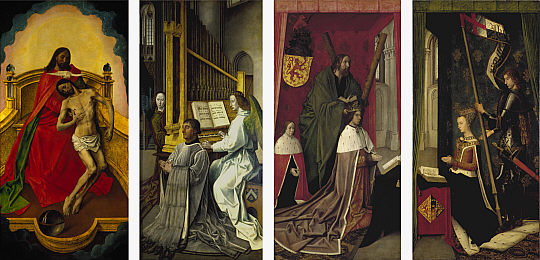
The Trinity Altarpiece, also known as the Trinity Altar Panels, is a set of four paintings in oil on wood thought to have been commissioned for the Trinity College Kirk in Edinburgh, Scotland, in the late fifteenth century.[1] The panels are now part of the British Royal Collection and are loaned to the Scottish National Gallery.[2]
They are now univerally attributed to the Netherlandish artist Hugo van der Goes, with studio assistance, and probably represent the inner and outer panels of the wings of a triptych. The presumed central panel is lost; probably it contained a Virgin and Child. Van der Goes died in 1482, and the prince presumed to be the future James IV of Scotland was born in 1473; he appears to be at least five years old. A second son born in 1478 is not shown.[3] As with the royal portraits in the Hours of James IV of Scotland a few years later, it is presumed that drawings were made in Scotland and sent to the artist.

The painting in the church was described as a "burd" ("board") on 17 May 1516 when John Stewart, Duke of Albany made an offering at the high altar on Trinity Sunday.[4]
The work represents a rare example of religious art in Scotland to have survived the iconoclasm of the Scottish Reformation in 1560; the central panel was perhaps destroyed at this point. The painting was taken to England at the Union of the Crowns and in 1617 is recorded as in the collection of Anne of Denmark, wife of James VI and I, at Oatlands.[5] In 1618 she gave it to her son Prince Charles, who presented the painting to the Duke of Buckingham.[6]
- ^ Duncan Macmillan, Scottish Art, 1460–1990 (Mainstream, 1990), p. 18.
- ^ National Galleries of Scotland
- ^ Page at The Royal Collection
- ^ Accounts of the Lord High Treasurer of Scotland, vol. 5 (Edinburgh, 1903), 79 "for offerand to the He Altar and burd".
- ^ Jill Harrison, 'Fresh Perspectives on Hugo van Goes' Portrait of Margaret of Denmark and the Trinity Altarpiece', The Court Historian, 24:2 (2019), p. 123 doi:10.1080/14629712.2019.1626108
- ^ Wendy Hitchmough, 'Setting the Stuart court: placing portraits in the performance of Anglo-Spanish negotiations', Journal of the History of Collections, 32:2 (July 2020), pp. 245-264.